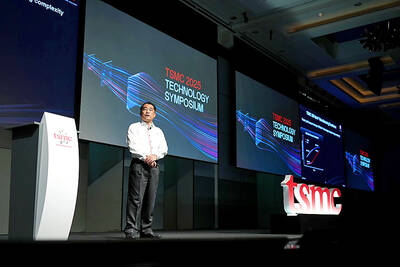Asian economic growth will slow at some point but demand for raw materials from countries such as China is expected to continue, the chairman of the world’s largest mining company said yesterday.
BHP Billiton’s Don Argus said commodity markets would be volatile in the short term because of the global financial crisis but he was confident longer-term market fundamentals would support growth in demand.
“I have no doubt that economic growth in the Asian region will slow at some point but, if I look at China specifically, the slowdown is concentrated in regions oriented to the light export sector,” Argus said.
“The sectors of the economy oriented more towards domestic consumption are still performing well despite increasing input costs, particularly for energy,” Argus said.
“We expect Asian demand for our products to continue,” he said.
The Anglo-Australian giant, which this year reported a record profit of US$15.4 billion, produces iron ore, coal, oil and gas — products much in demand in rapidly developing Asian nations.
In an annual report to shareholders, Argus said the economies of developing countries were central to the world’s economic growth amid the lessening influence of Europe and the relative shrinkage of the US economy.
“As the world’s largest diversified resources company, we are watching the creation of competitor companies that are spearheading the economic emergence of countries like Russia, Brazil and China.”
He said these economic shifts provided the context for BHP Billiton’s hostile takeover bid for Rio Tinto, the world’s No. 3 miner.
Argus said the two firms together could “help meet the developing economies’ demand for resources better and faster than the two companies do apart.”
Rio has rejected BHP’s 3.4-for-one share offer, saying it significantly undervalues the company.
BHP Billiton also said yesterday it intended to supply uranium to China for decades to come as the Asian superpower ramps up its nuclear energy program.
The chief executive of the Anglo-Australian miner, Marius Kloppers, said BHP Billiton was “very actively positioning” to take advantage of China’s move towardsgreater use of nuclear energy.
“As China is developing its nuclear program, what it’s doing is it’s gearing up for a bigger build program,” Kloppers said in a video address sent to shareholders.
“That will take a couple of years, but clearly we are positioning the company to, from our side, participate in that over decades, not just a couple of years,” he said.
BHP Billiton, whose Olympic Dam in South Australia holds the world’s largest known uranium reserves, said nuclear energy could help cut back on carbon emissions, which are generated from the burning of fossil fuels such as coal.
“If the world is serious about cutting carbon emissions, then you cannot have a debate without the nuclear piece in that debate, because it is the most efficient way to cut carbon emissions,” Argus said.
Australia and China last year ratified a nuclear agreement clearing the way for the export of uranium to feed Beijing’s giant nuclear power program.

DEMOGRAPHICS: Robotics is the most promising answer to looming labor woes, the long-term care system and national contingency response, an official said Taiwan is to launch a five-year plan to boost the robotics industry in a bid to address labor shortages stemming from a declining and aging population, the Executive Yuan said yesterday. The government approved the initiative, dubbed the Smart Robotics Industry Promotion Plan, via executive order, senior officials told a post-Cabinet meeting news conference in Taipei. Taiwan’s population decline would strain the economy and the nation’s ability to care for vulnerable and elderly people, said Peter Hong (洪樂文), who heads the National Science and Technology Council’s (NSTC) Department of Engineering and Technologies. Projections show that the proportion of Taiwanese 65 or older would

Nvidia Corp yesterday unveiled its new high-speed interconnect technology, NVLink Fusion, with Taiwanese application-specific IC (ASIC) designers Alchip Technologies Ltd (世芯) and MediaTek Inc (聯發科) among the first to adopt the technology to help build semi-custom artificial intelligence (AI) infrastructure for hyperscalers. Nvidia has opened its technology to outside users, as hyperscalers and cloud service providers are building their own cost-effective AI chips, or accelerators, used in AI servers by leveraging ASIC firms’ designing capabilities to reduce their dependence on Nvidia. Previously, NVLink technology was only available for Nvidia’s own AI platform. “NVLink Fusion opens Nvidia’s AI platform and rich ecosystem for

Taiwan Semiconductor Manufacturing Co (TSMC, 台積電) yesterday said it is building nine new advanced wafer manufacturing and packaging factories this year, accelerating its expansion amid strong demand for high-performance computing (HPC) and artificial intelligence (AI) applications. The chipmaker built on average five factories per year from 2021 to last year and three from 2017 to 2020, TSMC vice president of advanced technology and mask engineering T.S. Chang (張宗生) said at the company’s annual technology symposium in Hsinchu City. “We are quickening our pace even faster in 2025. We plan to build nine new factories, including eight wafer fabrication plants and one advanced

‘WORLD’S LOSS’: Taiwan’s exclusion robs the world of the benefits it could get from one of the foremost practitioners of disease prevention and public health, Minister Chiu said Taiwan should be allowed to join the World Health Assembly (WHA) as an irreplaceable contributor to global health and disease prevention efforts, Minister of Foreign Affairs Lin Chia-lung (林佳龍) said yesterday. He made the comment at a news conference in Taipei, hours before a Taiwanese delegation was to depart for Geneva, Switzerland, seeking to meet with foreign representatives for a bilateral meeting on the sidelines of the WHA, the WHO’s annual decisionmaking meeting, which would be held from Monday next week to May 27. As of yesterday, Taiwan had yet to receive an invitation. Taiwan has much to offer to the international community’s